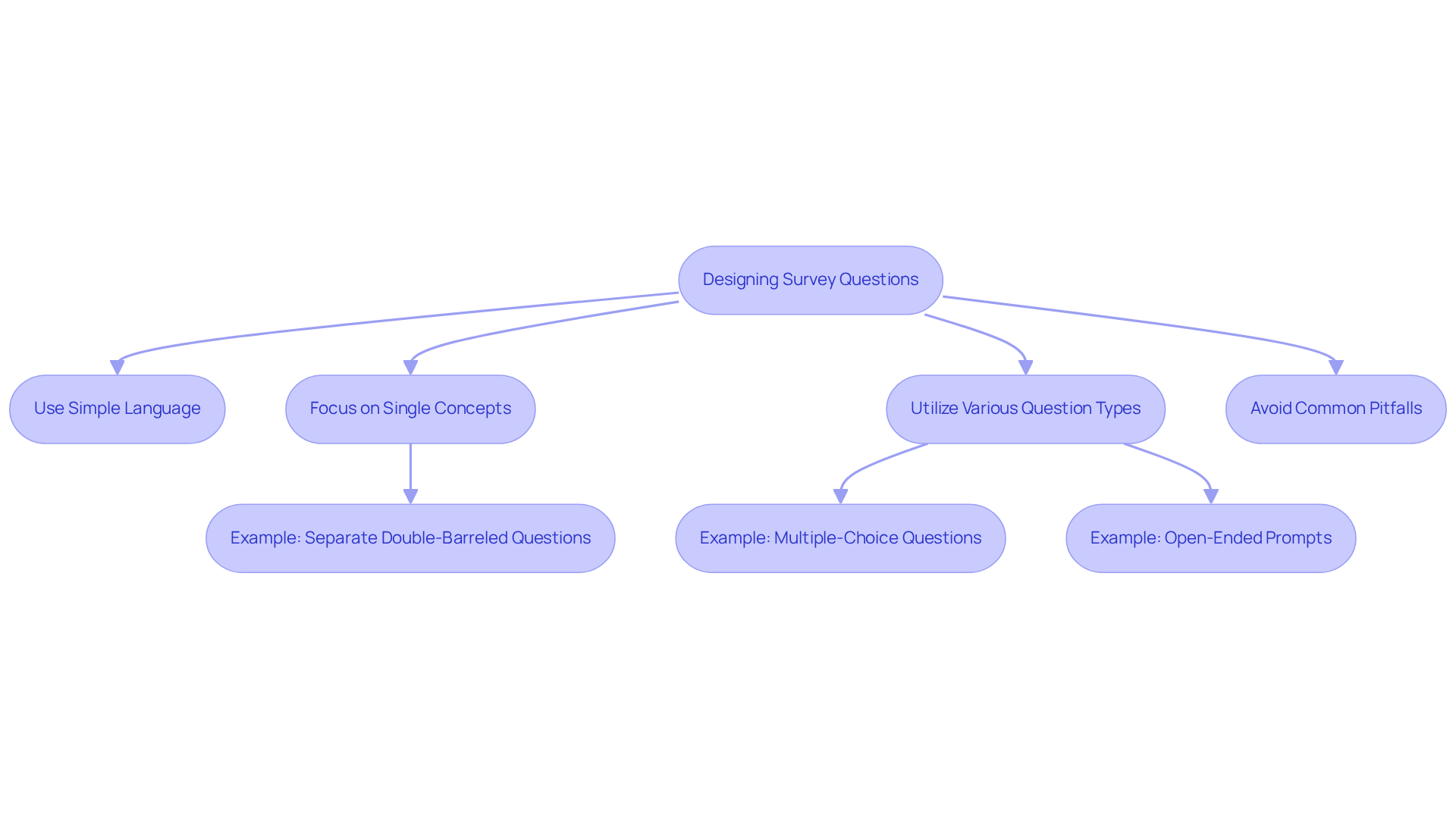4 Best Practices for Your Meeting Scheduler Survey Success

Introduction
Creating an effective meeting scheduler survey goes beyond merely asking questions; it requires a deep understanding of users’ needs and preferences. With a remarkable 68% of customers favoring businesses that offer online appointment booking, it’s crucial for organizations to align their scheduling practices with these expectations. But how can you ensure that your survey design captures actionable feedback while steering clear of common pitfalls?
This article explores best practices that not only boost survey effectiveness but also cultivate a more user-friendly scheduling experience. By implementing these strategies, you pave the way for continuous improvement and heightened customer satisfaction.
In today’s fast-paced environment, communication inefficiencies can hinder operational success. Addressing these challenges through a well-crafted survey can significantly enhance user engagement and streamline scheduling processes. Let’s delve into the unique features of effective survey design that can transform your approach and drive results.
Identify User Needs and Preferences
To effectively identify client needs and preferences, it’s crucial to start with thorough preliminary research. This involves conducting:
- Questionnaires
- Interviews
- Focus groups
with prospective participants as part of the meeting scheduler survey to gather insights into their scheduling habits, preferred meeting times, and the challenges they face with current methods. Utilizing audience personas can help represent various demographic segments, ensuring that survey questions align with their unique needs. For instance, if individuals express a desire for flexibility in scheduling, it’s essential to include options that allow them to suggest multiple time slots. This strategy not only enhances satisfaction among individuals but also increases the likelihood of obtaining actionable feedback.
Statistics reveal that 68% of customers prefer businesses that offer online appointment booking, underscoring the importance of aligning scheduling practices with customer expectations. Furthermore, providers who offer both phone and internet booking are scheduled 24% more often than those relying solely on phone-based options, highlighting the necessity for multiple booking channels. Incorporating best practices, such as clear objectives and concise agendas, can significantly enhance meeting effectiveness. Alarmingly, only 30% of meetings are deemed productive, while 71% are considered unproductive by employees. By focusing on user preferences and employing effective research methods, organizations can create a more efficient and user-friendly scheduling experience.

Craft Clear and Concise Survey Questions
When designing survey inquiries, it’s crucial to prioritize simplicity and clarity. Using straightforward language is essential; avoid jargon or technical terms that may confuse respondents. Each inquiry should focus on a single concept to eliminate ambiguity. For example, instead of asking, “How satisfied are you with the scheduling process and the options available?” consider separating it into two distinct questions: “How satisfied are you with the scheduling process?” and “How satisfied are you with the options available for scheduling?” This approach not only clarifies the purpose of each inquiry but also enables more accurate analysis of the information collected.
Moreover, consider utilizing a variety of inquiry types. Multiple-choice questions can effectively gather numerical data, while open-ended prompts can provide valuable qualitative insights. As W. Edwards Deming wisely stated, “Without information, you’re just another person with an opinion.” This underscores the importance of collecting clear and actionable feedback through thoughtfully crafted prompts.
Be mindful of common pitfalls, such as leading questions or double-barreled inquiries, which can skew results and lead to misinterpretation of data. By concentrating on clarity and participant engagement, you can ensure that your questionnaire effectively captures the insights necessary to drive informed decisions. Embrace these strategies to enhance your survey design and achieve operational efficiency.

Conduct Pre-Launch Testing and Feedback
Before you launch your questionnaire, conducting a pilot test with a representative group from your target audience is essential. This critical step allows you to gather valuable insights regarding the clarity of your questions, the duration of the survey, and the overall participant experience. Encourage participants to voice any uncertainties about specific inquiries or report any technical issues they encounter. For example, if a prompt seems ambiguous, their feedback can help you refine it for better clarity.
Moreover, consider implementing A/B testing; by comparing different versions of questions or formats, you can determine which variations yield more effective responses. This iterative process not only enhances the quality of your questionnaire but also builds greater confidence in the data collected. Research indicates that effective pilot testing can significantly boost participant engagement and satisfaction, leading to more reliable insights. Alarmingly, 45% of product launches are delayed due to incorrect assumptions about customer desires, highlighting the necessity of thorough pilot testing.
As Jason Jacobson, Senior Director of Consumer Insights, points out, enhancing the participant experience in market research is vital for obtaining quality insights. Additionally, integrating both qualitative and quantitative approaches during pilot testing can provide a comprehensive understanding of user feedback, ensuring that your assessment is both well-rounded and effective.

Analyze Results for Continuous Improvement
After gathering survey results, examining the information is crucial to uncover trends and patterns that can drive operational efficiency. Employing statistical tools quantifies responses, while visualizations – such as charts and graphs – enhance interpretation. As Hilary Mason aptly notes, “The data alone cannot give you all the answers you’re looking for,” highlighting the necessity of context in data analysis. Recognizing shared themes in open-ended feedback offers deeper insights into participant experiences.
For instance, if multiple respondents express challenges in finding suitable meeting times according to the meeting scheduler survey, consider implementing features that allow users to propose several time slots or integrate with their calendars for improved availability tracking. Tools like Tableau or Google Data Studio are invaluable for visualizing responses, facilitating effective communication of results. Establishing a feedback loop by sharing results with participants and informing them of any changes made based on their input fosters trust and encourages ongoing participation in future surveys.
By aligning with current trends in data visualization, which emphasize clarity and actionable insights, you ensure that user feedback directly informs enhancements in scheduling tools. Avoid common pitfalls such as overcomplicating visualizations or neglecting to follow up with participants, as these can undermine the effectiveness of your analysis.

Conclusion
To achieve success with meeting scheduler surveys, understanding and addressing user needs is paramount. Communication inefficiencies can hinder organizational effectiveness, making it essential to leverage comprehensive research methods. By designing surveys that prioritize clarity, organizations can foster a more efficient and user-friendly scheduling experience. This approach not only enhances participant satisfaction but also increases the likelihood of obtaining valuable feedback that can drive improvements.
Key practices include:
- Conducting thorough preliminary research to identify user preferences
- Crafting clear and concise survey questions
- Implementing pre-launch testing to refine inquiries
- Analyzing results for continuous improvement
Each of these steps contributes to a more effective survey process, ensuring that the insights gathered are both actionable and relevant. By employing these strategies, organizations can significantly enhance the effectiveness of their scheduling practices.
Ultimately, the significance of a well-executed meeting scheduler survey cannot be overstated. It serves as a vital tool for aligning scheduling practices with user expectations, thereby improving overall efficiency and satisfaction. Embracing these best practices will not only lead to better data collection but also foster a culture of continuous improvement, ensuring that organizations remain responsive to the evolving needs of their users.
Frequently Asked Questions
What methods can be used to identify client needs and preferences?
Effective methods include conducting questionnaires, interviews, and focus groups with prospective participants to gather insights into their scheduling habits, preferred meeting times, and challenges with current methods.
How can audience personas assist in understanding user needs?
Audience personas help represent various demographic segments, ensuring that survey questions align with the unique needs of different groups, which can lead to more relevant and actionable feedback.
Why is flexibility in scheduling important for clients?
Flexibility in scheduling is important because it allows individuals to suggest multiple time slots, enhancing their satisfaction and increasing the likelihood of obtaining useful feedback.
What percentage of customers prefer businesses that offer online appointment booking?
Statistics reveal that 68% of customers prefer businesses that offer online appointment booking.
What is the impact of providing multiple booking channels?
Providers who offer both phone and internet booking are scheduled 24% more often than those relying solely on phone-based options, highlighting the necessity for multiple booking channels.
What are some best practices for enhancing meeting effectiveness?
Best practices include setting clear objectives and creating concise agendas to improve meeting productivity.
What is the current perception of meeting productivity among employees?
Alarmingly, only 30% of meetings are deemed productive, while 71% are considered unproductive by employees.
How can organizations create a more user-friendly scheduling experience?
By focusing on user preferences and employing effective research methods, organizations can enhance the scheduling experience for clients.
